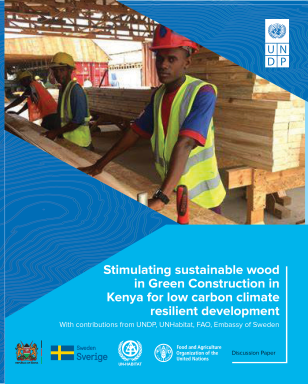Stimulating sustainable wood in Green Construction in Kenya for low carbon climate resilient development

Stimulating sustainable wood in Green Construction in Kenya for low carbon climate resilient development
pdf (1MB)
DownloadStimulating sustainable wood in Green Construction in Kenya for low carbon climate resilient development
February 29, 2024
The forest sector plays a key role in socioeconomic development of Kenya and contributes to 3.6 % to the country’s GDP1 excluding environmental services. The sector supports the urban and rural population through the provision of wood fuel and other non-timber forest products and services. Currently the sector provides direct jobs for up to 50,000 and indirect jobs to approximately 600,000. The sector is largely underdeveloped against its potential that can be unlocked through commercial forestry.
At COP28 Kenya joined a coalition of 17 countries that committed to promoting the use of sustainable wood in Green Construction2. This commitment is backed by a robust policy and regulatory framework as well as a booming construction industry. In addition, Government has set an ambition to grow 15 billion trees and increase it plantation area to 750,000ha.
Wood has long been integral to traditional building techniques. However, technological progress has spurred the development of engineered wood products capable of substituting fossil-based materials like steel and concrete in large-scale construction, while offering environmentally friendly construction material. Wood-based materials are renewable, recyclable, and if sourced sustainably, have minimal fossil carbon emissions, and reduced environmental footprints.
Globally, numerous governments have implemented policies aimed at enhancing the sustainability of their construction sectors, including sustainably sourced and produced wood materials. At the same time, it requires not only wood-encouraged construction policies but also forest registration and management systems, as well as timber traceability systems at the national level, to comply with tightening international standards and requirements.
The paper examines the policy environment, supply and processing of timber as well as the uptake of sustainable wood in Kenya’s construction industry. The paper recommends interventions required to stimulate the nascent industry in the short, mid, and long-term. These are summarized in 5Ps. Policy coherence, Production at scale, Processing efficiency, Piloting and Popularizing.
Specifically, there is a need for coherence in policy to promote the uptake of wood in construction. For instance, the building code(draft) acknowledges wood as an alternative construction material however there are regulatory nuances that place it as a temporary material thus it is considered a high risk material by insurance and financing entities.
Currently, Kenya has a wood supply deficit of 10.3 million m3. Wood for construction requires specific properties that are sustainably sourced. The national commercial forestry sector will require support through providing a portfolio of competitive genetic resources which also enable mitigation of risks such as pests and diseases and climate change. Kenya has to make progress in the establishment of Standards and Regulations including adopting international standards for timber grading to ensure consistency and reliability in the quality of wood used in construction and other industries. Kenya has to also improve efficiency in the processing of wood, current efficiency is 30% coupled with investments in
Finally, the shift in public Awareness and Industry Collaboration: Educating the public and collaborating with the construction industry, architects, and engineers about the benefits of using sustainable wood timber can increase its demand and adoption. At the onset, proposals are for piloting by both the public and private- sectors.

 Locations
Locations